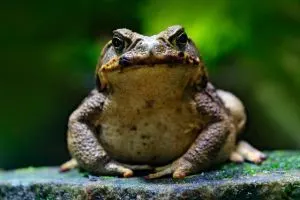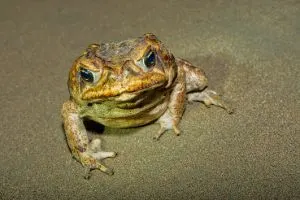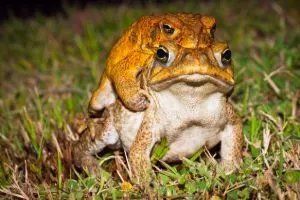Cane Toad Care [Complete Care Guide]
Cane toad care can be an easy and rewarding experience for beginner amphibian keepers. Although considered to be an invasive species in areas such as Australia, Cane toads can still make fascinating pets.
This terrestrial species is relatively easy to care for. Although toxic to other animals, Cane toads can be handled safely. Here’s our complete guide to Cane toad care.

Quick reference section
- Experience level: Beginner to Intermediate
- Scientific name: Rhinella Marina (formerly Bufo Marinus)
- Family: Bufonidae
- Alternate names: Marine toad, Giant Neo-tropical toad
- Size and weight: Between 4 and 6 inches long, up to 9.5 inches wide. Females much larger than males
- Lifespan: 10-15 years in wild, possibly up to 35 years in captivity
- Diet: Carnivorous – mainly small rodents, invertebrates, smaller reptiles or amphibians
- Conservation status: Least concern
Interesting facts about Cane toads
Cane toads were used as a form of pest control in sugar cane fields. Due to their voracious appetite, they were introduced to areas like Australia.
However, these toads reproduce quickly and can adapt to new environments. They are now considered a pest in many areas, most notable Australia, because of their damaging effect on local wildlife.
In Australia, Cane toad toxin (bufotenin) is labeled as a Class One drug, alongside heroin and LSD. It can also kill many animals such as dogs.
Despite their alternative name of Marine toad, this species does not usually live near large bodies of water. Instead, they are largely terrestrial.
What do Cane toads look like?

Cane toads are a large species that have warty, dry skin. Coloration varies from gray to reddish or greenish browns. Their undersides are cream-colored with black or brown speckled patches.
Their eyes are horizontal and golden, which distinguishes them from other species. Their toxin (paratoid) glands are located behind the eyes.
Where can Cane toads be found?
Initially, Cane toads were native to parts of Central and South America. They have gradually spread to U.S states like Florida and Texas, as well as the Pacific Islands. They have also been introduced to Australia and the Philippines.
What kind of habitat do Cane toads live in?
In their native areas, these terrestrial toads mainly live in sub tropical forests. In areas where they have been introduced, Cane toads frequent woodland and open grass areas. They have also spread to urban areas.
What does the Cane toad eat?
Cane toads are nocturnal carnivores. They mainly feed on invertebrates, small rodents, and smaller amphibians and reptiles. They have even been known to eat birds and bats! In areas near humans, Cane toads will scavenge food refuse or things like dog and cat food.
How do Cane toads breed?

Cane toads reproduce extremely quickly, which has why they are now classed as pests. Females will lay long strings of eggs, sometimes up to 25,000 in one go. These strings are laid in water and can stretch up to 20 meters long.
The tadpoles usually hatch within 48 hours and develop into juveniles within four weeks. Both the eggs and tadpoles of the Cane toad are also toxic. Tadpoles tend to form shoals at the bottom of rivers.
What predators do Cane toads face?
In their native habitat, Cane toads are usually preyed on by large reptiles like caimans, snakes, or water monitors. Some birds of prey and even crows have learned how to feed on Cane toads. Rats may also prey on them in introduced areas.
To defend themselves against predators, Cane toads can secrete a toxic milky fluid from their paratoid glands. This will kill many animals, include dogs. They also puff themselves up to appear larger.
Where can I buy a Cane toad?
Several reptile sites online stock Cane toads. Check that the Cane toad is captive-bred, rather than caught in the wild.
Cane Toad Habitat (Care Sheet)
Below we get into creating the perfect setup for your cane toad. Check out the video too which gives a nice overview about cane toads and shows what an enclosure can look like.
Suggested Products
- Enclosure: Reptizoo 67 Gallon
- Substrate: Zoo Med Frog Moss
- Cleaner: Zilla Terrarium Cleaner
- Heating: Zilla Terrarium Heat Mat (50-60 Gallon)
- Sprayer: Misting sprayer
- Supplement: Zoo Med Calcium with D3
- Optional: Feeding tongs
Enclosure
Being a larger species, Cane toads need a lot of space. A glass terrarium of at least 40 gallons for a male works well. Females are generally larger, and will likely need a 4′ x 2′ x 2′ terrarium. Glass enclosures allow heat to escape, helping to achieve the right temperature for Cane toads.
The tank pictured above is a 67 gallon Reptizoo glass terrarium which should allow your cane toad or toads if you choose to have plenty of space.
Personally I think it’s always better to buy the setup correct the first time rather then buying one too small and then having to upgrade.
As with many terrestrial amphibians, Cane toads still require moist conditions. Substrates should therefore be composed of a mix of damp moss and bark chips. Soil can also be used provided it is free of fertilizers which could prove toxic for your toad. Regularly misting the substrate helps retain moisture.
Cane toads will require a water dish, as this is mainly where they will dispose of waste. Make sure it is small enough so that the toad will not drown. A water level that doesn’t reach past their mouth is ideal. Only use de-chlorinated water, and change daily.
Cleaning
As Cane toads have a large appetite, they will produce a lot of waste. Cleaning the toad’s water bowl daily should deal with most mess, but remove any other feces as soon as you can.
Spot clean daily. For more thorough cleanings, aim for every two weeks or if it’s ok, monthly. Make use of a temporary tank while you’re cleaning.
Use a disinfectant that is safe for amphibians, and replace the substrate. Zillas Terrarium cleaner is a safe option. Make sure any potential chemicals are gone, or they could harm the toad.
Temperature
As natives of hotter subtropical areas, Cane toads need a temperature of around 75 F. The safest way to do this is by using a heat mat. Place the mat on one side of the terrarium and control it using a thermostat.
Providing a temperature gradient allows your toad to regulate its temperature. The gradient should be relatively small; not dipping below around 73 F. At night, temperatures can safely drop to around 68 F.
Bulbs shouldn’t be necessary, and may provide too much heat. Temperatures should not exceed 82 F as this may start to dehydrate your toad.
Humidity
The Cane toad’s natural habitat is quite humid, and they require moisture to drink. Mist the enclosure a few times a day with de-chlorinated water.
Make sure the substrate stays damp. The humidity should be around 60%, so use a hygrometer to keep track of it
You can do this either with a fogger, misting system or a sprayer. Generally a sprayer is fine, but later if you want to automate the process you can look into a fogger or a misting system.
Lighting
Lights may generate too much heat for your Cane toad. In their natural habitat, Cane toads avoid direct sunlight and are nocturnal. Providing a well supplemented diet will meet all of the toad’s needs.
However, if you use live plants in the enclosure, you can use a low wattage fluorescent UV tube to keep them alive. If doing so, put the light on a 12 hour day-night cycle to simulate a natural environment. Make sure the light generates as little heat as possible.
Accessories
Cane toads really like a safe hiding spot. Using something like a small ceramic flowerpot is a good idea. You can also use a variety of live or artificial plants to provide cover.
Using logs, bits of bark, rocks and branches will help mimic the Cane toad’s natural environment. Artificial plants are preferred as they eliminate the need for an overhead light.
Feeding
As carnivores, Cane toads will mainly eat live foods. Crickets or locusts are an ideal staple. Meal worms and wax worms can add variety. Once a week you can also use small mice. Cat or dog food can also be an occasional treat.
All insects should be gut-loaded before feeding. Dust one meal with supplements such as calcium and Vitamin D3 at least once a week. For younger toads, increase this to two or three meals per week.
If feeding your Cane toad directly, use forceps or tongs.
You can buy the insects at your local pet store or even online at several places including Amazon.
Alternatively you can also create your own farm if you have enough demand. Check out our guides for more on that if it is something you are interested in.
Food Guides:
Temperament and handling

It is absolutely possible to handle your Cane toad, but you should take some precautions. If you’re handling your toad with bare hands, make sure to wash them before and after handling. Alternatively, wear surgical or latex gloves.
This prevents oils from your hands from harming your toad. It also helps avoid irritation from the Cane toad’s toxin. Avoid touching your eyes or mouth while handling your toad.
Although no human deaths from Cane toad toxin have been recorded, it is wise to take precautions, especially if you also have other pets. Dogs or cats can die from exposure to Cane toad toxin.
Cane toads are relatively tame and docile if handled correctly, and should not release their toxin if they feel safe. As nocturnal amphibians, they will not move much during the day.
Cane toads will also shed their skin, which can be interesting to observe. The toad will then usually eat the husk of dead skin.
Aestivation
If you make sure that humidity and temperature levels remain correct, a Cane toad should not go into aestivation. However, an unexpected drop in temperature may cause this to occur.
If this does happen, your toad will cocoon itself in dead skin to conserve moisture. It will also bury itself in the substrate.
Do not feed the toad or disturb it during this process. Make sure water is always on hand, and make sure it is de-chlorinated.
Gradually raise the temperature and humidity over a period of several days to bring your Cane toad out of aestivation.
Health concerns
Due to their voracious appetite, Cane toads can become obese if overfed. Regularly feeding them cat or dog food can also cause them to rapidly gain weight. These foods should only be very occasional treats.
A lack of calcium or vitamin D can be harmful for your toad. Make sure they have a varied diet and are supplemented correctly.
Like many amphibians, Cane toads are incredibly sensitive to toxins or harmful oils. Regular clean the terrarium, and wash your hands before and after handling.
An interesting YouTube video about the Cane toad
Conclusion
Cane toads are relatively easy to care for, as they don’t need hugely specific set up requirements. They can also be handled, with proper precautions, which makes them a pretty interesting pet.
However, their toxicity can prove deadly to other animals if safety measures aren’t taken. They are also nocturnal, so won’t be active much during the daytime.
If you are in the market for a pet toad, be sure to check out our best pet toads article to see what options are out there.
Table of Contents
